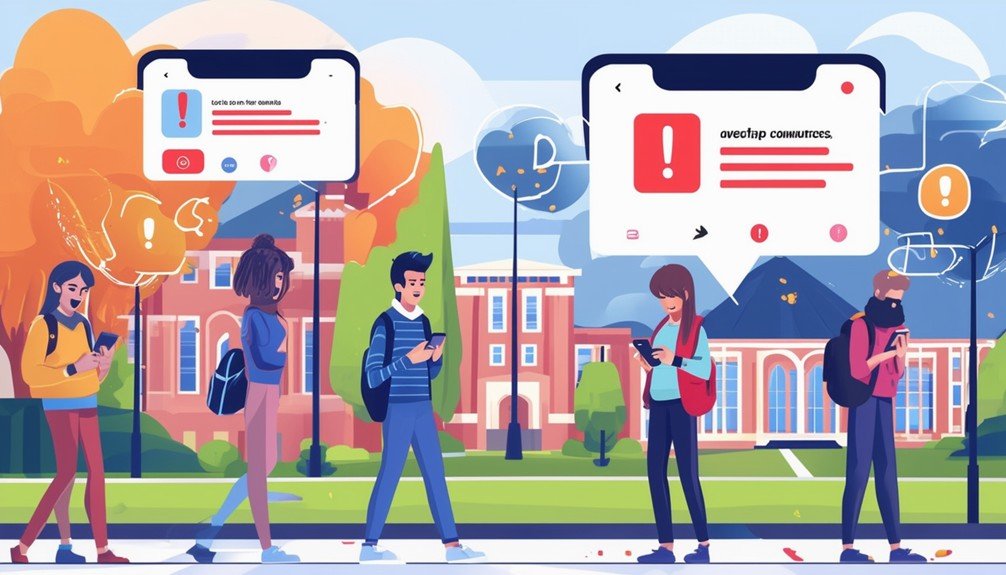Effective emergency alerts on college campuses guarantee everyone stays safe. Use text messages for urgent notifications and social media for wider reach. Tailor alerts to specific needs, and always provide clear, concise, and accurate information from reliable sources. Simplify the registration process and promote the value of signing up. Collaborate with student organizations for better outreach and trust. Utilize eye-catching branding and consistent messaging. Regularly test and improve your alert system. Conduct training and drills to prepare everyone for emergencies. Learn about the latest strategies to protect your campus in various scenarios.
Table of Contents
ToggleKey Takeaways
- Utilize multiple communication channels, including social media and text messaging, for wide and swift alert dissemination.
- Ensure alerts are clear, concise, and provide actionable steps to address the emergency.
- Regularly test and update the alert system to maintain efficiency and reliability.
- Collaborate with student organizations to increase outreach and build trust in the alert system.
- Simplify the registration process and offer incentives to encourage student sign-ups for emergency alerts.
Market Your Alert System
To effectively market your alert system, leverage social media platforms where students and staff are already active. Social media is a powerful tool to promote your notification systems due to its widespread use among the campus community. Announce the alert system’s features and benefits on platforms like Facebook, Twitter, and Instagram to capture attention and encourage registrations.
Collaborate with student media to amplify your message. Student-run newspapers, radio stations, and online publications can provide valuable coverage, guaranteeing your notification systems reach a broader audience. This method not only boosts awareness but also adds credibility, as students trust these sources for campus-related information.
Distribute posters and fliers in high-traffic areas such as dormitories, libraries, and dining halls. Visual reminders reinforce the importance of staying informed and guide students on how to sign up for alerts. Setting up information booths at strategic campus locations can offer direct engagement opportunities, allowing students and staff to ask questions and understand the system’s functionality.
Lastly, include detailed information about the alert system in student and employee materials, such as welcome packets and orientation guides. This secures that everyone in the campus community knows how to stay updated during emergencies, fostering a culture of preparedness and communication.
Keep Students Engaged

Engage students by tailoring emergency alerts to their specific needs and making sure messages are clear and actionable. By customizing alerts, you can maintain their relevance and attention. For example, use text messaging, which 82% of colleges employ, for urgent notifications that require immediate action. This guarantees students receive critical information promptly.
Clear and concise communication is key. With 96% of higher education institutions utilizing emails for notifications, it’s vital to make sure that these messages are straightforward and provide actionable steps. Include specific instructions so students know exactly what to do to stay safe.
Avoid information overload by sending only pertinent alerts. Almost 50% of colleges now use social media for emergency notifications. Utilize these platforms to reach students where they already spend their time but make sure the content remains focused on urgent and relevant information.
Regular testing of your alert system is important. This ensures that the system will function correctly during an actual emergency, guaranteeing campus safety. Regular drills and tests help keep students familiar with the alert system and its importance, thereby maintaining their engagement.
Build Trust in Alerts

To build trust in emergency alerts, you need to validate the information is accurate and up-to-date. Combat disinformation by using reliable sources and providing clear, concise details. Regularly test the system and include actionable steps to boost credibility and effectiveness.
Combat Disinformation Challenges
In an era where social media can rapidly spread misinformation, providing accurate and timely emergency alerts is essential for maintaining trust on college campuses. Combatting disinformation challenges involves guaranteeing that each emergency notification is clear, concise, and relevant. By addressing these challenges, you can reinforce the reliability and effectiveness of your alert system.
To build trust in your alerts, communicate through reliable sources and consistently offer actionable steps for individuals. This not only provides clarity but also empowers the campus community to take appropriate measures during emergencies. Regularly test the alert system for functionality and dependability to ensure that it works seamlessly when needed. This proactive approach reassures the community that the system is dependable.
Here are some key strategies to combat disinformation and build trust:
- Provide Accurate Information: Always share up-to-date, detailed information to prevent the spread of false news.
- Use Reliable Sources: Guarantee that all notifications come from verified, credible sources to enhance trust.
- Offer Actionable Steps: Include specific actions people can take to stay safe, which boosts their confidence in the system.
- Regular Testing: Conduct frequent tests of the emergency alert system to demonstrate its reliability and effectiveness.
Ensure Accurate Information
Trust in your emergency alert system relies on consistently delivering accurate, up-to-date information. When a campus emergency notification is sent, it must be sourced from reliable sources to minimize the risk of spreading misinformation. Social media can often be a breeding ground for false information, so your alerts need to stand out as the dependable source.
Accurate information is crucial not only for credibility but also for the safety of everyone on campus. Guarantee that every alert is detailed yet clear and concise. This approach helps recipients quickly understand the situation and take necessary actions. Including actionable steps in your notifications, like ‘seek shelter immediately’ or ‘avoid the main quad,’ demonstrates the system’s effectiveness and value.
Regular testing of your emergency alert system is vital to ensure it functions correctly when needed most. This proactive measure can identify potential issues before they become critical, guaranteeing that accurate information is always disseminated during real emergencies.
| Key Aspect | Importance | Action Steps |
|---|---|---|
| Accurate Information | Builds credibility and trust | Verify sources before sending alerts |
| Reliable Sources | Minimizes risk of misinformation | Use official channels only |
| Clear and Concise | Enhances comprehension | Avoid jargon, be straightforward |
| Actionable Steps | Demonstrates system’s value | Provide clear instructions |
Simplify Registration Process
How can we make the process of registering for emergency alerts easier for everyone on campus? Simplifying the registration process for emergency notification systems is essential to enhance student safety. A streamlined approach not only increases participation but also secures that everyone on campus is quickly informed during emergencies.
To simplify the registration process, consider these strategies:
- Clear Communication: Clearly convey the value of signing up for emergency alerts. Emphasize how important it is for student safety and provide straightforward instructions.
- Easy Access: Make the registration process available through multiple channels. Integrate sign-ups into existing campus systems like student portals or mobile apps to reduce barriers.
- Regular Updates: Encourage regular updates of contact information. Make it simple for users to update their details to guarantee the accuracy and effectiveness of the alerts.
- Incentives: Offer rewards for new sign-ups. Small incentives or acknowledgments can motivate more people to register.
Branding and Promotion

Effective branding and promotion are essential for ensuring that the emergency alert system gains widespread recognition and engagement on campus. By implementing a consistent branding strategy, you can increase recognition and make the alert system more memorable to students. Use eye-catching logos, colors, and slogans to create a strong, recognizable presence.
Promotion through various channels like social media, posters, and fliers will boost visibility. Make sure to craft engaging content that grabs students’ attention. Contests and interactive posts can make your promotional efforts more appealing. Collaborating with student organizations can greatly enhance outreach, allowing you to reach a wider audience more effectively.
Incorporate incentives for new sign-ups to encourage students and faculty to register for the alert system. This not only improves campus safety but also drives engagement.
Here’s a quick comparison of effective promotional strategies:
| Strategy | Benefit |
|---|---|
| Social Media Campaigns | High engagement and broad reach |
| Collaboration with Orgs | Enhanced outreach and credibility |
| Incentives for Sign-ups | Increased registration rates |
Utilize Technology
Leveraging technology guarantees that emergency alerts swiftly reach everyone on campus, improving overall safety and responsiveness. Implementing multi-channel notification methods guarantees that messages are delivered through various platforms such as text messages, emails, and mobile apps. This approach maximizes the chances of reaching every individual promptly, regardless of their preferred communication device.
Integrating emergency alerts with existing campus technology is vital for seamless communication. By ensuring compatibility with smartphones, laptops, and other devices, you streamline the process and enhance the system’s efficiency. Providing options for language preferences in alerts further assures that the diverse student and staff population receives critical information in a comprehensible manner.
Utilizing geolocation features in emergency alerts allows for targeted notifications to specific campus areas. This means, during localized incidents, only the affected regions receive pertinent information, reducing confusion and improving response times.
Consider these key points for effective technology utilization:
- Multi-channel notification: Use text messages, emails, and mobile apps.
- Device compatibility: Assure alerts work on smartphones, laptops, etc.
- Language preferences: Offer alerts in multiple languages.
- Geolocation features: Target specific campus areas during emergencies.
Enhance Communication
To improve communication during emergencies, you’ll want to establish clear protocols and utilize multiple channels. This guarantees everyone knows how and where to get critical information. By doing so, you can keep the campus community informed and prepared.
Establish Clear Protocols
Clear communication processes during emergencies can save lives and ensure everyone on campus is aware of how to respond effectively. To enhance safety on college campuses, it’s essential to establish robust communication processes for emergency alerts. These processes should be clear, consistent, and well-understood by everyone in the community.
Start by outlining specific steps for different emergency scenarios, guaranteeing that alerts are tailored and targeted to the situation at hand. Regular updates and follow-ups are crucial to keep everyone informed and engaged throughout the emergency. Additionally, incorporating two-way communication systems will enable feedback and encourage active participation.
Training is another key aspect. Both staff and students should be well-versed in these communication processes, so they know exactly how to act when an alert is issued. This training should be ongoing to keep everyone prepared and aware of any updates to the processes.
Consider the following points to establish clear communication processes:
- Regularly update and follow-up on alerts to keep everyone informed.
- Incorporate two-way communication systems for feedback and active participation.
- Provide specific steps for different emergencies to ensure targeted alerts.
- Train staff and students on these processes to enhance preparedness.
Utilize Multiple Channels
In addition to establishing clear protocols, utilizing multiple communication channels guarantees that emergency alerts reach the widest possible audience on campus. By incorporating a variety of platforms such as mass notification systems, text messages, and social media, you can make sure that critical information is disseminated quickly and effectively.
Text messages are particularly effective, with over 80% of colleges relying on them for emergency notifications. They provide a direct and immediate way to reach students and faculty. Social media, used by nearly 50% of colleges, offers another essential communication tool. Posting alerts on platforms like Twitter and Facebook can rapidly spread information to a broad audience.
Leveraging high-traffic areas on campus is also important. Intercoms, external loudspeakers, and radio announcements can broadcast emergency updates to large groups simultaneously. Additionally, mobile apps can push notifications directly to users’ devices, ensuring that everyone stays informed, no matter where they are on campus.
Utilizing these multiple channels creates a thorough communication strategy that leaves no one out. By doing so, you maximize the likelihood that everyone on campus will receive and act on emergency alerts swiftly and appropriately.
Conduct Training and Drills
Regular emergency drills on college campuses are important for making sure everyone knows how to respond effectively in a crisis. By conducting training sessions, you educate both students and faculty on the necessary steps to take when different alerts are issued. These sessions provide a thorough understanding of response strategies, ensuring everyone is well-prepared.
One vital aspect of these drills is testing the effectiveness of communication channels. By doing so, you can identify any weaknesses in the system and improve them before an actual emergency occurs. Additionally, these drills allow you to review and refine emergency response procedures based on real-time feedback, thereby enhancing overall campus safety.
Here are some key actions to keep in mind:
- Schedule regular training sessions to maintain continuous preparedness.
- Test communication channels during drills to pinpoint and address any issues.
- Review drill outcomes and refine response strategies for better efficiency.
- Encourage widespread participation to make drills as realistic as possible.
Organizing these drills and training sessions can greatly strengthen your campus’s emergency preparedness. By being proactive, you make sure that everyone knows their role and can act promptly and efficiently in any crisis.
Conclusion
To wrap up, consider this: 90% of students are more likely to respond to emergency alerts if they’re familiar with the system. By marketing your alert system, keeping students engaged, and simplifying registration, you’ll build trust and enhance communication. Don’t forget to leverage technology and conduct regular training drills. With these steps, your campus will be better prepared for any emergency. Stay proactive, and your alerts will be effective.
Frequently Asked Questions
What Is the Best School Alert System?
The best school alert system uses multi-channel notifications, works on various devices, and supports language preferences. It integrates with existing campus tech and uses geolocation for targeted alerts, ensuring everyone’s informed and safe during emergencies.
What Is an Example of an Emergency Notification Message?
An example of an emergency notification message is: ‘Campus lockdown in effect due to active shooter threat, seek shelter immediately.’ This message is concise, clear, and includes specific instructions to guarantee everyone’s safety.
Is There an App for Emergency Alerts?
An ounce of prevention is worth a pound of cure. Yes, there are apps for emergency alerts. Many universities use them to provide real-time updates, ensuring you’re informed and safe during campus emergencies.
What Is Alertus for Schools?
Alertus for Schools is a robust emergency notification system designed for educational institutions. It uses desktop notifications, IP speakers, alert beacons, and high-power speaker arrays to guarantee immediate communication with students, faculty, staff, and visitors during emergencies.





